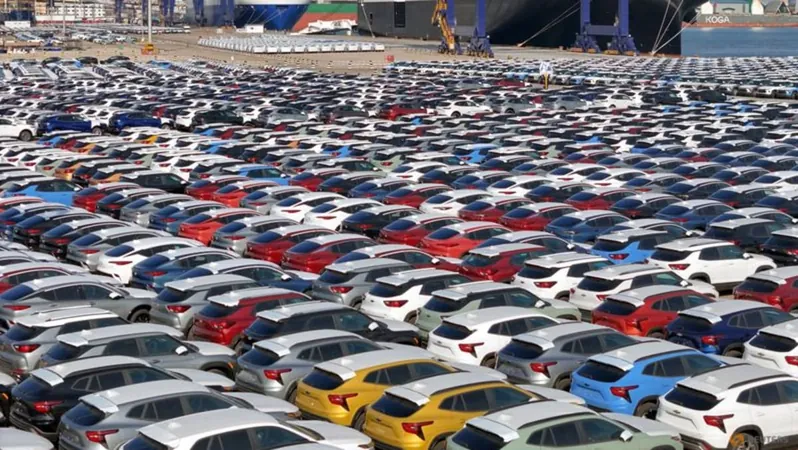
Is Southeast Asia the New Home for Chinese Goods? The Implications Are Massive!
2025-01-13
Author: Wei
SINGAPORE: As China's export machine revs up, Southeast Asia is becoming a key target for its goods.
Analysts warn that as geopolitical tensions escalate and the demand for Chinese products in Western markets wanes, this trend could deepen, making it critical for Southeast Asian nations to formulate a cohesive response to China's influence.
Advantages and Disadvantages of Influx
The advantages and disadvantages of this influx are stark. On one hand, consumers in Southeast Asian countries benefit from the availability and affordability of a wide range of Chinese products. However, local industries are facing significant challenges due to the inability to compete with the low prices offered by Chinese manufacturers.
Doris Liew, an economist at Malaysia's Institute for Democracy and Economic Affairs (IDEAS), highlights, “Local businesses are struggling against eroding profit margins and factory closures, resulting in substantial job losses.” This phenomenon extends beyond the region, impacting global markets and labor dynamics.
A Surge in Chinese Exports
China's current economic climate, marred by a cooling property sector and sluggish consumer demand, has led to a spike in exports, which account for a significant 20% of its GDP. According to recent customs data, China’s exports saw a remarkable 7.1% rise in 2024, reaching a staggering value of 25.45 trillion yuan (about US$3.47 trillion).
The country is not only focusing on low-cost staple items but is also ramping up the export of high-tech goods such as electric vehicles and solar panels. The combined export value of these "new trio" products reached 1 trillion yuan last year, marking an impressive growth of 900% compared to a decade ago.
The Double-Edged Sword
This deluge of Chinese products provides a financial boon for consumers, particularly low-income households that benefit from competitively priced goods. Moreover, high-tech products, like electric vehicles, are gaining a reputation for offering quality at reasonable prices.
Conversely, the wave of inexpensive imports is putting immense pressure on local manufacturers, which are seeing their production capabilities dwindle. Indonesia's textile and ceramic industries are some of the hardest hit. Muhammad Zulfikar Rakhmat from the Center of Economic and Law Studies notes, “Last year, more than 50,000 jobs were lost due to factory closures in these sectors.”
Thailand is facing similar dilemmas, with around 2,000 factory shutdowns reported between July 2023 and June 2024, resulting in the loss of numerous jobs in an industry that represents nearly 25% of its GDP.
Trade Tensions Loom
The influx of Chinese goods is not just an economic issue but also a source of social unrest. Protests have erupted in several ASEAN countries, highlighting growing concerns over the impact of cheap imports on local businesses. Vietnam has already taken action by launching an anti-dumping investigation into Chinese products and extending tariffs on aluminum imports.
Thailand is also responding proactively, identifying key products for anti-circumvention duties and instituting a 7% value-added tax on low-cost imports. Furthermore, Indonesia is contemplating imposing tariffs as high as 200% on certain goods to safeguard its domestic industries.
While immediate tensions are rising, analysts, like Priyanka Kishore from Asia Decoded, believe that a major confrontation is unlikely. China remains a critical supplier for Southeast Asia, and heavy tariffs could ultimately harm local businesses reliant on Chinese imports.
Navigating the Future
The future landscape of trade in Southeast Asia will largely depend on how countries navigate their relationship with China. Many nations emphasize the importance of attracting Chinese investments and advancing industries like electric vehicle manufacturing to foster technological growth.
IDEAS’s Doris Liew expresses optimism that Southeast Asia will not merely become a "dumping ground" for surplus goods, citing the region's relatively low purchasing power and existing measures to counteract potential market distortions. If managed well, stronger economic ties with China could result in infrastructure improvements and job creation.
Indonesia’s heavy reliance on Chinese imports is indicative of the complex relationship at play. Although trade with China comprises a significant chunk of Indonesia's overall trade, concerns about over-reliance linger. Rakhmat notes that while consumers appreciate affordable imports, balancing these benefits with the health of domestic industries remains a persistent challenge.
 Brasil (PT)
Brasil (PT)
 Canada (EN)
Canada (EN)
 Chile (ES)
Chile (ES)
 Česko (CS)
Česko (CS)
 대한민국 (KO)
대한민국 (KO)
 España (ES)
España (ES)
 France (FR)
France (FR)
 Hong Kong (EN)
Hong Kong (EN)
 Italia (IT)
Italia (IT)
 日本 (JA)
日本 (JA)
 Magyarország (HU)
Magyarország (HU)
 Norge (NO)
Norge (NO)
 Polska (PL)
Polska (PL)
 Schweiz (DE)
Schweiz (DE)
 Singapore (EN)
Singapore (EN)
 Sverige (SV)
Sverige (SV)
 Suomi (FI)
Suomi (FI)
 Türkiye (TR)
Türkiye (TR)
 الإمارات العربية المتحدة (AR)
الإمارات العربية المتحدة (AR)